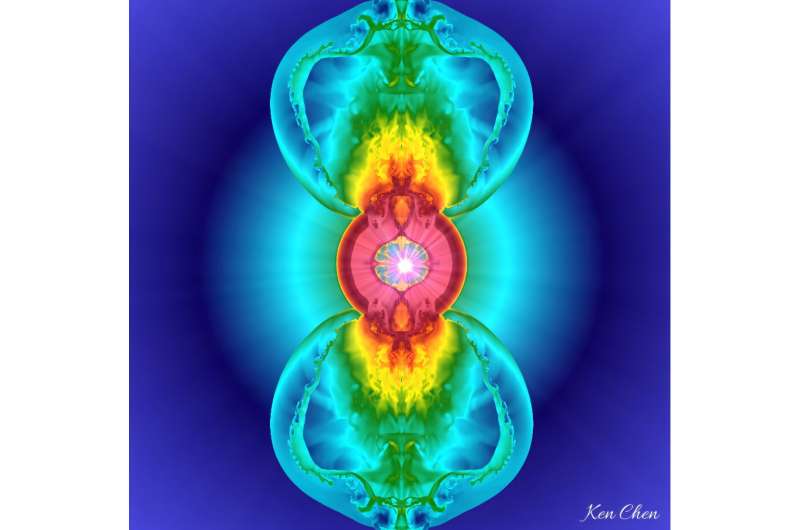
November 20, 2024 by Ken Chen, ASIAA
Collected at: https://phys.org/news/2024-11-supernova-explosion-simulations-reveal-physics.html
Stars with masses between 10 and 30 times that of the sun, in their final evolutionary stages, form an iron core that ultimately collapses into a neutron star. This collapse releases a tremendous amount of gravitational potential energy through neutrinos, triggering a shockwave that destroys the entire star.
The shock wave propagates supersonically within the star and plays a crucial role in the supernova formation process. When the shockwave reaches the surface of the star, the photon energy within the shockwave begins to diffuse effectively to its front edge, producing an extremely bright flash known as the “supernova shock breakout.”
Depending on the mass and radius of the progenitor star, this breakout flash lasts for a brief period, typically around a few hours, with radiation primarily concentrated in X-rays and ultraviolet, occurring well before the visible light curve. Therefore, it can be used as a precursor signal for predicting supernova explosions.
New simulations published in The Astrophysical Journal focus on the well-known supernova 1987A, which provides a unique opportunity to study the evolution from core-collapse supernovae to supernova remnants.
The research revealed that the environment of the progenitor star significantly impacts the breakout flash, indicating that the flash can be used to investigate the conditions surrounding supernova explosions and infer the relationship between the circumstellar medium and mass loss of the star.
 Interaction between shockwaves and interstellar medium during early supernova explosions: In the early stages of a supernova explosion, the powerful shockwave impacts the interstellar medium surrounding the star. This interstellar medium often exhibits a “doughnut” structure, which may be formed by the mass loss from the star during its late evolutionary stages. When the shockwave collides with this material, it produces extremely bright emissions and intense turbulent phenomena. The interaction between the shockwave and the surrounding material provides crucial clues for understanding the mass loss in late-stage stars and the dynamics of shockwave propagation. Credit: ASIAA/Wun-Yi Chen
Interaction between shockwaves and interstellar medium during early supernova explosions: In the early stages of a supernova explosion, the powerful shockwave impacts the interstellar medium surrounding the star. This interstellar medium often exhibits a “doughnut” structure, which may be formed by the mass loss from the star during its late evolutionary stages. When the shockwave collides with this material, it produces extremely bright emissions and intense turbulent phenomena. The interaction between the shockwave and the surrounding material provides crucial clues for understanding the mass loss in late-stage stars and the dynamics of shockwave propagation. Credit: ASIAA/Wun-Yi Chen During the early stages of a supernova explosion, a powerful shockwave breaks through the star’s outer atmosphere, and the post-explosion gas is filled with turbulent structures. Credit: ASIAA/Wun-Yi Chen
During the early stages of a supernova explosion, a powerful shockwave breaks through the star’s outer atmosphere, and the post-explosion gas is filled with turbulent structures. Credit: ASIAA/Wun-Yi Chen
The multi-dimensional simulations showed that fluid instabilities during the shock breakout enhance the brightness of the flash and prolong its duration, differing significantly from previous one-dimensional simulations and fundamentally reshaping our understanding of breakout flashes for supernovae.
“The interaction between radiation precursors and the surrounding medium is crucial for forming the shock breakout signal. Our new multi-dimensional, multi-band simulations can more accurately describe the complex radiative fluid dynamics during shock breakout,” noted Wun-Yi Chen, who is the first author of the paper.
Dr. Masaomi Ono, a co-author of the study at ASIAA, adds, “This research clearly demonstrates that even for spherical explosions, the shock breakout signals derived from two-dimensional radiative fluid dynamics may differ from those predicted by one-dimensional models. Multi-dimensional radiative fluid dynamics is vital for assessing the shock breakout signals of core-collapse supernovae, especially in non-uniform circumstellar medium.”
“These simulations provide essential reference data for future observations and predictions of supernovae. Next-generation X-ray and ultraviolet space telescopes will capture more supernova shock breakout flashes, furthering our understanding of the early evolution of supernovae and the final evolution of massive stars,” emphasized Dr. Ke-Jung Chen, leader of the research team.
More information: Wun-Yi Chen et al, Multidimensional Radiation Hydrodynamics Simulations of SN 1987A Shock Breakout, The Astrophysical Journal (2024). DOI: 10.3847/1538-4357/ad7de3
Journal information: Astrophysical Journal

Leave a Reply